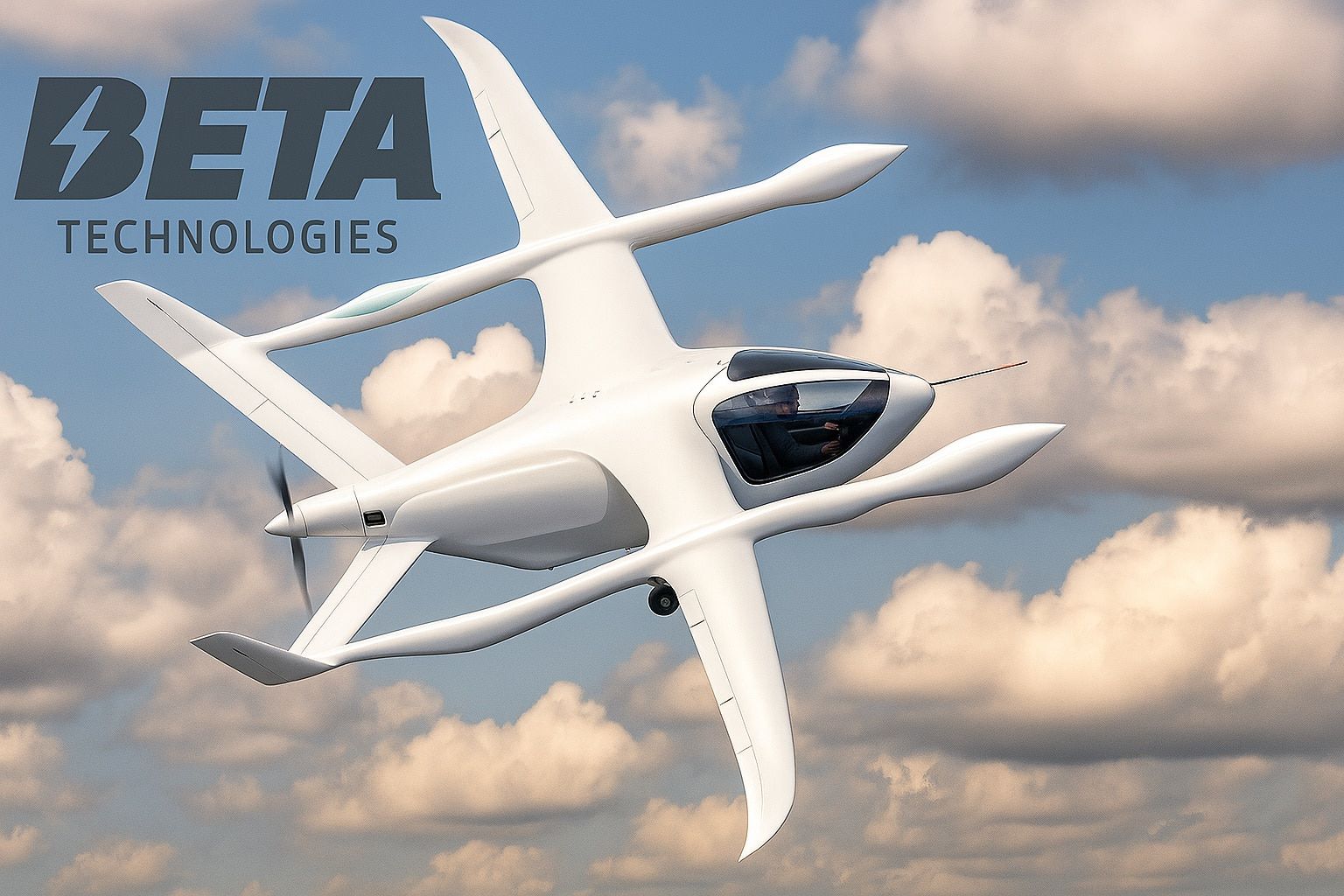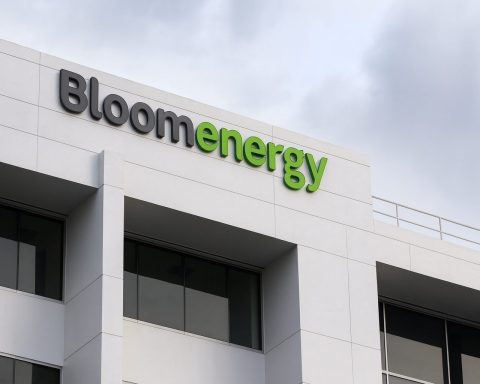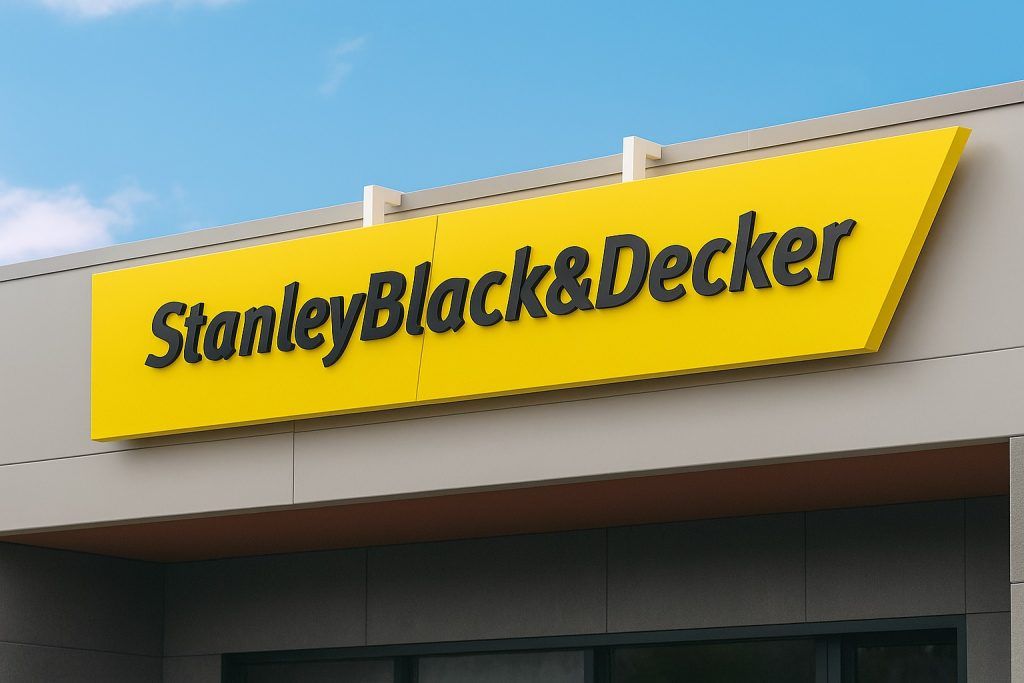- IPO Raises Over $1 Billion: Vermont-based Beta Technologies priced its IPO at $34 per share, above the expected range, raising about $1.01 billion and valuing the electric aircraft startup at roughly $7.4 billion [1] [2]. The offering was upsized to ~29.9 million shares amid strong demand and was reportedly 20× oversubscribed, signaling intense investor interest [3]. Beta’s stock debuts on the NYSE on Nov. 4 under ticker “BETA.” [4]
- Electrifying Vision: Founded in 2017 by CEO Kyle Clark, Beta develops electric aircraft – including a fixed-wing plane and a VTOL (“vertical takeoff and landing”) version, both called the Alia [5]. Beta’s aircraft have flown over 83,000 nautical miles in test flights across the U.S. [6]. In June, Beta’s Alia became the first electric plane to land at New York’s JFK Airport, carrying passengers ~70 miles in 45 minutes at a fuel cost of just ~$8 in electricity (versus ~$160 in fuel for a helicopter) [7] [8]. The all-electric planes run far quieter and emit ~84% less carbon than fossil-fueled helicopters [9], positioning Beta as a potential game-changer in climate-friendly aviation.
- High-Profile Backing & Deals: Beta had raised over $1.5 billion from private investors pre-IPO [10], including a recent $300 million investment from GE Aerospace in 2025 [11]. The startup has strategic partnerships and customers lined up: UPS plans to buy up to 150 of Beta’s eVTOL aircraft for cargo deliveries [12], United Therapeutics will use them to transport human organs [13], and Beta has U.S. Air Force contracts through the Agility Prime program. These deals, plus a network of 50+ charging stations already deployed across 22 states [14] [15], underscore Beta’s head start in building an electric aviation ecosystem.
- Riding a Resurgent Market: Beta’s IPO is launching amid a broader revival in listings and renewed investor appetite for tech and climate-focused companies. 2025’s IPO market has seen buzzy debuts from fintechs like Klarna and Chime [16], but Beta stands out as a rare aerospace offering. It’s the first Vermont company IPO in years [17] and one of the first pure-play electric aircraft makers to go public via a traditional IPO (many rivals used SPAC mergers in 2021). Analysts say Beta’s successful pricing “signals real confidence” in electric aviation [18], especially notable given lingering market volatility and even a recent U.S. government shutdown that briefly threatened to delay IPO timelines [19].
- Big Dreams, Big Challenges: Beta aims to certify its first aircraft by 2026–2027 [20], after which it can scale up deliveries for cargo, defense, and eventually passenger use. The company already operates a 17,500 m² factory in Vermont capable of producing 300 aircraft per year to meet future demand [21]. However, like others in the nascent eVTOL (electric vertical takeoff and landing) sector, Beta is not yet profitable – it lost about $183 million in the first half of 2025 on just $15.6 million in revenue [22]. All electric aircraft startups face a long road to regulatory approval and mass adoption; as one industry observer noted, “the regulatory timeline remains the biggest wild card” for eVTOL players [23]. Investors are betting on a massive future payoff – Morgan Stanley projects the urban air mobility market could reach $1 trillion by 2040 – but it will “likely take decades” for this industry to truly take off at scale [24] [25].
Beta Technologies’ Blockbuster IPO Debut
Beta Technologies officially hit Wall Street on November 4, 2025, ringing the NYSE opening bell to celebrate its public debut [26]. The company’s IPO priced at $34 per share, above the marketed range of $27–33 [27], which reflects strong investor demand. In fact, Beta upsized the offering from 25 million to 29.85 million Class A shares (with underwriters granted an option for ~4.48 million more) [28] [29]. This netted about $1.01–1.02 billion in fresh capital for the company, overshooting initial expectations of ~$825 million [30]. At the IPO price, Beta’s market capitalization comes out around $7.4–7.5 billion [31] [32].
The enthusiastic reception marks a milestone not just for Beta but for the broader IPO market. Electric aviation is a relatively niche, futuristic field, yet Beta’s successful raise underscores how investor sentiment has improved in late 2025. “Beta decided to offer millions more shares than it initially had planned” due to the strong demand [33], and traders on the NYSE floor even broke into chants of “Beta! Beta!” as CEO Kyle Clark rang the bell [34]. It’s an especially proud moment for Vermont – Beta’s listing is the first IPO by a Vermont-based company in many years [35], reflecting how a local startup has swiftly become one of the state’s most important companies, even before delivering a commercial product.
Wall Street’s embrace of Beta also highlights a tentative revival in U.S. equity listings. After a dry spell in 2022–2023, 2025 has seen a “resurgent IPO market” [36]. High-profile tech firms (from fintech to AI) have gone public this year, and Beta’s debut shows that investor appetite now extends to next-gen transportation and climate tech. Notably, Beta chose a traditional IPO route with underwriters like Morgan Stanley, Goldman Sachs, and BofA Securities [37], in contrast to many peers that went public via SPAC mergers during the last eVTOL hype cycle. By pricing above range, Beta signaled confidence – and indeed the deal was reportedly ~20 times oversubscribed [38], an eye-popping level of interest that allowed bankers to push the valuation higher. Early trading of BETA shares will be closely watched as a barometer: recent IPOs in 2025 have often popped on debut, and a strong first-day performance for Beta would reinforce the market’s optimism about electric aviation.
However, Beta’s leadership and investors appear mindful of balancing excitement with realism. The IPO timing came amid some external bumps – for instance, an October federal government shutdown threatened to stall SEC processes, though regulators issued guidance to keep IPO filings moving [39]. By clearing those hurdles and going public now, Beta locked in needed capital for the next phase of growth (and perhaps stole a march on competitors in fundraising). The focus now shifts to execution: Beta must convert this influx of cash into tangible progress on aircraft certification, manufacturing, and commercial launch in the coming years.
From Startup to Electric Aviation Pioneer
Beta Technologies’ journey from a scrappy startup in Burlington, VT to a publicly traded electric aircraft pioneer has been remarkably swift. The company was founded in 2017 by Kyle Clark, an engineer, pilot, and former professional hockey player known for an ambitious vision of cleaner skies [40] [41]. Frustrated by the noise, expense, and emissions of traditional aircraft, Clark posed a simple question: “If electric vehicles can run on the road, why not in the air?” [42]. Since then, Beta has been singularly focused on making electric flight a reality, building a comprehensive ecosystem of aircraft and charging infrastructure from the ground up.
At the heart of Beta’s product lineup is the ALIA – a versatile electric aircraft platform with two main variants. The ALIA CTOL is a conventional fixed-wing plane (needing a runway for takeoff/landing), while the ALIA VTOL is a vertical takeoff and landing craft that uses distributed rotors to lift off like a helicopter [43]. Both versions share many components and are powered by advanced lithium-ion batteries and electric motors, avoiding fossil fuels entirely. The Alia design, inspired in part by the Arctic tern bird, features a sleek composite airframe with four lifting propellers for vertical flight and one pusher propeller for forward cruise [44]. It can carry up to 5 people or around 1,400 lbs of cargo and is targeting a range of roughly 250–330 nautical miles on a charge, depending on configuration [45] [46]. For context, that range could cover a flight from New York City to Boston or Charleston, SC on a single charge [47].
Beta has methodically tested and demonstrated its aircraft to prove their real-world viability. In an early vote of confidence, the U.S. Air Force and FAA themselves have piloted Beta’s planes – the ALIA has been used in USAF training missions and was flown by FAA officials as part of test programs [48]. In June 2025, Beta made headlines when its Alia became the first all-electric aircraft to land at John F. Kennedy International Airport in New York, after a successful 70-mile hop from East Hampton [49]. That symbolic milestone showcased the aircraft’s potential to operate in and out of major urban areas. The flight took about 45 minutes and consumed roughly $7–8 worth of electricity [50] [51] – an astonishing 95% cost savings compared to the ~$160 in fuel a conventional helicopter would burn for the same trip [52] [53]. “Quieter, cheaper, little-to-no emissions” is how Clark paints the electric flight future [54]. Indeed, Beta estimates each electric flight can cut carbon emissions by ~84% relative to a helicopter [55], aligning with global climate goals.
Beyond test flights, Beta has rolled out the support network needed for electric aviation. The company has installed a network of charging stations (essentially high-speed electric aircraft chargers) at over 50 locations across the U.S. and Canada [56]. These can recharge an Alia’s batteries in under an hour [57], and many are co-located at airports or UPS facilities to enable point-to-point operations without relying on traditional hubs. Beta even designed the chargers to have second-life battery storage (using retired aircraft batteries) and to double as charging points for electric ground vehicles [58] – a clever way to integrate with broader electrification efforts. By September 2025, Beta had built charging sites in 22 states, and that network continues to grow [59]. This infrastructure-first approach gives Beta an early advantage; as the industry grows, Beta could earn recurring revenue from charging services and support, not just aircraft sales [60] [61].
Beta’s rapid progress and lofty mission have earned it prominent accolades. In fact, TIME Magazine named Kyle Clark to its “TIME100 Climate” list for 2025, recognizing Beta’s potential to slash aviation emissions and transform regional transportation [62] [63]. “Imagine the skies without jet fuel and combustion engines – quieter, cheaper, little-to-no emissions,” TIME wrote, describing Clark’s vision [64]. Beta’s feat of flying an electric plane at the 2023 Paris Air Show and completing a European tour that year further proved the technology’s readiness for prime time [65]. All of this momentum is fueled by a growing team: as of mid-2025 Beta had over 800 full-time employees (many based at its Burlington Airport headquarters) [66]. A significant portion are engineers, technicians, and even test pilots – Clark himself frequently serves as a test pilot for Beta’s prototypes [67] [68], embodying the hands-on culture of the company.
Despite its startup age, Beta has attracted serious industrial and financial backing. Prior to the IPO, Beta’s investor list read like a who’s-who of climate tech funding: Amazon’s Climate Pledge Fund, Fidelity, TPG Rise Climate, and more contributed to a $368 million Series B in 2023 that valued Beta at $2.4 billion [69] [70]. The biggest endorsement came in October 2025 when GE Aerospace made a $300 million strategic investment [71]. Not only did GE inject capital, it also partnered with Beta on developing hybrid-electric propulsion (a turbogenerator system that could extend the range of electric aircraft) [72]. This collaboration with an aviation giant both validates Beta’s technology and could yield next-gen products (for example, a hybrid cargo plane for longer routes). According to The Tech Buzz, GE’s stake “signaled confidence from one of aviation’s biggest players” and helped justify Beta’s aggressive IPO valuation [73] [74].
Equally important are Beta’s early customers and contracts that hint at commercial demand. In a high-profile 2021 deal, UPS announced it would purchase up to 150 of Beta’s eVTOL aircraft for its express logistics network [75] [76]. UPS expects to use Beta’s electric planes to ferry time-sensitive packages between sorting facilities, creating “a micro air feeder network without the noise or emissions of traditional aircraft,” as UPS’s chief information and engineering officer Juan Perez put it [77] [78]. The first 10 Beta aircraft for UPS were (at the time) slated for delivery by 2024–25 pending certification [79], and UPS is also adopting Beta’s charging stations at its hubs [80]. Beta’s launch customer is another visionary company: United Therapeutics, which plans to use the electric aircraft to transport human organs for transplant, cutting down transit time and pollution in life-saving missions [81]. Additionally, Beta secured significant contracts with the U.S. Air Force’s Agility Prime program [82]. Through Agility Prime, military pilots have been evaluating Beta’s aircraft for potential defense logistics uses – from moving cargo between bases to medical evacuation – further de-risking the tech and providing modest revenue in the interim. All these partnerships illustrate that Beta is not building in a vacuum; a real market need exists for the capabilities its aircraft promise, across cargo, medical, defense, and eventually passenger travel [83].
In short, Beta has moved the electric aviation dream closer to reality, earning it a reputation as a front-runner in the field. “Among the hundreds of companies building eVTOL aircraft, Beta has established itself as the clear No. 2, behind Joby Aviation,” observed IEEE Spectrum in late 2023 [84]. That’s high praise, considering the fierce competition (and it notably placed Beta ahead of other well-funded rivals). Beta’s edge may lie in its pragmatic approach – pursuing cargo and military applications first, which have somewhat more straightforward paths to market than air taxis – as well as its focus on core enabling technologies (like charging and propulsion) that can generate additional revenue streams. As Beta enters the public markets, it does so with an impressive foundation: working aircraft prototypes, its own factory and charging network, marquee strategic allies, and a clear roadmap to certification.
Rivals and a Resurgent Advanced Air Mobility Sector
Beta’s IPO arrives at a pivotal moment for the Advanced Air Mobility (AAM) or eVTOL sector. After a burst of enthusiasm around 2021 that saw numerous electric aircraft startups go public via SPAC mergers, the industry navigated a couple of turbulent years of technical delays and skeptical sentiment. But 2025 has brought renewed momentum. A number of Beta’s rivals have made tangible progress – and their stocks have reflected it – helping to rekindle investor excitement that likely benefited Beta’s offering.
Several high-profile electric aircraft companies have already gone public in recent years. Joby Aviation (NYSE: JOBY) and Archer Aviation (NYSE: ACHR) both hit the stock market in 2021 via SPAC deals [85]. Lilium (NASDAQ: LILM) and Vertical Aerospace (NYSE: EVTL) did the same. While going public early gave these firms capital, it also meant their stock prices were volatile as timelines stretched. By 2025, however, there have been signs of maturation. For instance, Joby – often considered the leader – achieved key FAA test milestones and even garnered a contract to provide aerial rides during the 2028 Los Angeles Olympics as an official air mobility partner [86]. Archer has similarly struck partnerships, including one with defense contractor L3Harris to collaborate on electric military aircraft [87]. These developments have not gone unnoticed by investors. As Tech Buzz noted, both Joby and Archer “have seen their stock prices accelerate as they beef up production and ink international partnerships” [88]. In fact, by late 2025 Joby’s market capitalization had swelled to around $14 billion, and Archer’s to roughly $7 billion, reflecting optimism that they may be first to launch commercial eVTOL services [89].
Beta, by contrast, stayed private longer and pursued a traditional IPO – a path that might indicate stronger financial footing or simply a desire to avoid the SPAC hype cycle. That restraint may have paid off: by the time of its IPO, Beta could point to real revenue (albeit modest) and substantive partnerships as discussed, helping persuade investors to grant it a valuation in line with Archer’s and not far behind Joby’s, even before any fully certified product. As an aerospace startup, Beta now joins an “increasingly crowded field” of publicly-traded eVTOL and new-space firms [90]. These include not only the air taxi developers but also companies like Surf Air Mobility (which went public in 2023) and Firefly Aerospace (a rocket builder that IPO’ed in 2025) [91]. The mix of listings shows how the broader category of futuristic flight – from urban air taxis to space launch – is capturing investor imagination.
Despite the competition, there is a sense that multiple winners can coexist given the vast potential market. Analysts often cite eye-opening figures: Morgan Stanley famously estimated the total addressable market for autonomous urban aircraft could reach $1 trillion by 2040 (base case) and potentially as high as $9 trillion by 2050 in a bull case [92] [93]. Even if such forecasts prove optimistic or delayed, they imply there is room for several players – from passenger taxi services to cargo haulers – to each build multi-billion dollar enterprises. Beta’s differentiation lies in its dual focus on passenger and cargo applications from the start, whereas some competitors are squarely focused on air taxis for people. By having a foot in both camps, Beta could tap into revenue sooner via cargo/logistics missions (which face slightly more lenient regulatory paths) while still chasing the ultimate prize of mainstream passenger travel.
Another factor lifting the sector is policy support and regulatory progress. Governments have started to pave the way for eVTOL operations. In the U.S., the FAA in Oct 2024 officially created a new “powered-lift” aircraft category and training rules, which enabled test pilots to begin certifying on eVTOL designs [94]. And just in September 2025, the FAA signaled it would allow pilot-led passenger flights for eVTOL prototypes, accelerating testing and demonstrating safety in real-world scenarios [95]. These moves were crucial for Beta: the company filed for its IPO in late September 2025, shortly after that regulatory green light for carrying test passengers [96]. It indicated to investors that the regulatory winds are shifting favorably – slowly, but steadily. Additionally, initiatives like the U.S. Air Force’s Agility Prime and reported White House interest (there was mention of “President Trump’s announced pilot program for electric aircraft testing” boosting the sector [97]) suggest bipartisan support for maintaining America’s edge in aviation innovation. Globally, countries like UK, Japan, and Singapore are also crafting advanced air mobility plans. Such support, alongside rising environmental urgency to decarbonize transport, adds tailwind to the eVTOL industry.
Of course, one cannot ignore that hype and reality don’t always align in this space. The earlier SPAC frenzy left some investors wary after a few eVTOL stocks initially sank post-merger when development proved harder than anticipated. But by 2025, those same companies have shown real technological strides – flying full-scale prototypes, building factories, and even starting certification test flights. For example, Joby and Archer each have multiple prototype aircraft flying; both started FAA certification testing in 2023–24 and aim for commercial service around 2025–2026. Beta’s timeline (first certification by 2026–27 [98]) is just slightly behind, which from an investor perspective might mean Beta can learn from the trailblazers’ experiences. The bottom line is that advanced air mobility is evolving from concept to execution, and Beta’s public debut both benefits from and contributes to that momentum. Its success will depend on navigating the same gauntlet of challenges facing rivals – but the collective progress suggests the dream of electric flight is inching closer to reality.
Opportunities and Challenges on the Horizon
With a war chest of over $1 billion from the IPO, Beta Technologies now faces the real work of converting its promise into a sustainable business. The company’s roadmap for the next few years is ambitious. By late 2026 or early 2027, Beta hopes to earn FAA type certification for the first version of ALIA (likely the CTOL aircraft) [99]. Certification is essentially the license to operate commercially – it means the aircraft meets all safety and airworthiness standards. Beta will then need additional certifications for the VTOL variant and for manufacturing. Meeting these targets will require intense engineering effort, rigorous testing, and close coordination with regulators. The IPO funds will largely go toward scaling up manufacturing, continuing flight tests, and navigating the certification process, which can cost hundreds of millions of dollars.
Beta has already invested in manufacturing capacity – its newly built Vermont factory could eventually produce 300 aircraft per year at full tilt [100] – but ramping production is its own challenge. The company must source large quantities of batteries, electric motors, and avionics, potentially creating supply chain bottlenecks. It will also need to expand its workforce in production, customer training, and support services as it transitions from an R&D outfit to a commercial manufacturer. As Capital.com noted, Beta’s business model isn’t just selling planes; it also plans to provide charging services, maintenance, training, and software to customers for ongoing revenue [101] [102]. Standing up those support operations in parallel is a complex task, but crucial for long-term profitability.
Speaking of profitability – it remains a distant goal. Right now Beta (like its eVTOL peers) is deeply in the red, essentially a pre-revenue company with small pilot program earnings. In its IPO filings, Beta disclosed a net loss of $183 million for Jan–June 2025, widening from a $137 million loss in the same period a year prior [103]. Revenues in that first half of 2025 were only $15.6 million (albeit more than double the ~$7.6 million of H1 2024) [104]. These sales likely come from early demonstrator contracts (such as Air Force funding or prototype deliveries to partners), not full commercial operations. The cash burn will continue at a high rate as Beta builds out production lines and inventories in anticipation of certification. Investors are aware of this dynamic – in fact, Beta’s stock is essentially a bet on future growth, not current financials.
The biggest variables in Beta’s trajectory are technical and regulatory. Electric flight is still a new frontier, and unforeseen engineering issues could arise as Beta pushes its prototypes toward final design. The ALIA aircraft will need to meet strict safety standards; batteries and motors must be extraordinarily reliable, and redundant systems are required to ensure a single failure won’t lead to catastrophe. This is one reason the FAA has been cautious in certifying eVTOLs. Any setback in testing (e.g. a battery fire, a crash, or simply underperforming range) could force redesigns and delay certification timelines. As noted earlier, “the regulatory timeline remains the biggest wild card” for all players [105]. Beta and its investors are optimistic that FAA approval will come by 2027, but it’s not guaranteed – rivals like Joby and Archer originally hoped for 2024–25 launches and have slid into 2025–26. If the FAA process drags or if unforeseen safety questions arise, Beta might have to spend more cash over a longer period before revenue ramps up, potentially necessitating future fundraising.
Market adoption is another open question. Even once aircraft are certified, will customers readily embrace electric planes? Beta is somewhat shielded here by its focus on cargo and military early on – UPS, for example, is motivated to deploy eVTOLs to cut costs and emissions, and if Beta’s product is ready, UPS is likely to use them. Ditto for organ transport with United Therapeutics, where the value proposition (faster, point-to-point delivery) is clear. These initial use cases don’t depend on broad public acceptance, just on Beta proving reliability and cost savings to its clients. However, the ultimate prize is passenger travel – air taxis or shuttles that could, say, fly people from city centers to airports or between nearby cities. For that, consumer trust will be vital. eVTOL startups are keenly aware of this; they emphasize safety, low noise, and extensive testing to persuade the public. Beta’s aircraft, notably, have a pilot onboard (at least in early years), which may reassure passengers more than fully autonomous “flying cars.” Nonetheless, the company will have to build an impeccable safety record to convince regulators and riders to allow scaled operations. Any high-profile incident in the industry could set back public acceptance, a risk factor that all AAM companies share.
Despite the challenges, the upside if Beta succeeds is enormous. The global transportation market is measured in trillions of dollars, and aviation is a big slice of that. Beta doesn’t need to displace airlines or cars entirely; even capturing niche segments like regional cargo hops or urban air shuttles could generate hefty revenue. By one estimate, urban air mobility could account for 6% of global GDP by 2050 (around $9 trillion) in an optimistic scenario [106]. More conservatively, Morgan Stanley’s revised base case still sees $1 trillion in market size by 2040 [107]. Achieving that will require solving many puzzles (air traffic management for potentially thousands of new flying vehicles, noise and zoning concerns for rooftop vertiports, etc.), but it underscores why investors are pouring money into this sector today. As the Morgan Stanley research put it, once the technology and regulations fall into place, eVTOLs “could be as transformative as automobiles were in the early 20th century”, effectively re-inventing travel rather than just nibbling at the edges [108]. That is the scale of the prize Beta and its competitors are chasing.
Beta’s own management appears cautiously optimistic. While Clark’s team hasn’t publicly released long-term financial forecasts, their strategy implies a ramp-up toward the late 2020s. By 2027–2028, if certification is achieved, Beta could be delivering dozens of aircraft to paying customers like UPS and the Department of Defense. Revenues would start to climb from mere millions into the hundreds of millions. By the early 2030s, if passenger services come online (perhaps in limited markets or specific routes), Beta and its peers could begin addressing that trillion-dollar air taxi vision. However, it’s worth noting that competition will only intensify: established aerospace giants are circling the AAM space too. Boeing has a stake in Wisk Aero (developing an autonomous eVTOL), Airbus has its own prototypes, and new startups continue to appear. Beta will need to keep innovating to maintain an edge. Fortunately, its close relationships with partners like GE for hybrid systems and its diverse approach to markets give it a fighting chance to stay at the forefront.
Finally, from an investor’s lens, a key question is whether Beta can justify its lofty valuation in the coming years. At ~$7.5 billion market cap, Beta is valued higher than some regional airline companies – for a company with minimal revenue so far. To grow into that valuation, Beta will need to execute near-flawlessly on its roadmap. Market analysts have called Beta’s IPO valuation a “high-risk, high-reward” proposition [109]. If electric aviation truly takes off, early believers could see massive rewards – essentially, owning a piece of the “Tesla of the skies” in its infancy. But if development stalls or the market takes longer to materialize, Beta’s stock could languish or slide, as has happened with a few early SPAC-launched peers. The next 18–24 months will be critical to demonstrate progress: hitting certification milestones, perhaps securing additional big orders, and ideally reporting increasing revenue from pilot programs or initial deliveries. Each step forward will build confidence that Beta can someday generate solid profits ferrying people and goods through the skies.
Outlook: Cleared for Takeoff?
As of November 2025, Beta Technologies stands as one of the most intriguing public companies at the intersection of clean technology and aviation. The successful $1 billion IPO has given Beta the runway it needs to accelerate into its next phase. The company is now squarely in the spotlight – with shareholders to answer to – as it strives to launch a new era of electric flight. In many ways, Beta’s story encapsulates the promise of advanced air mobility: a bold idea to reinvent transportation, backed by cutting-edge engineering and significant capital, aiming to solve real problems (carbon emissions, traffic congestion, logistics bottlenecks) but facing a gauntlet of practical challenges.
There is a palpable excitement around Beta’s NYSE debut, but also a recognition of the hurdles ahead. Industry experts caution that patience will be key. “We’ve been preparing for this moment for years,” insiders say of the IPO – yet the journey of bringing electric aircraft to market is a marathon, not a sprint [110]. In the near term, success will be measured by engineering milestones and regulatory approvals. Over the long term, it will hinge on market adoption and profitable operations. The good news for Beta and its investors is that 2025 has shown tangible validation of the eVTOL field at large: prototypes are flying farther, big-name partners are signing on, and governments are crafting rules for this new class of aircraft. The trend line is upward.
For the general public, the idea of “flying taxis” and electric air couriers is moving from science fiction to foreseeable reality. Beta’s planes won’t be whisking New Yorkers across Manhattan tomorrow, but perhaps a few years from now, you might see a sleek electric aircraft quietly descending onto a downtown landing pad or hear that your overnight package flew part of the way on battery power. Those will be the moments when the electric aviation revolution truly takes off in everyday life. Beta Technologies, armed with fresh funds and a first-mover advantage, is poised to play a leading role in that revolution – if it can deliver on the promise that has investors so eagerly aboard.
Sources:
- Reuters – “Electric aircraft maker Beta Technologies raises over $1 billion in US IPO” (Nov 4 2025) [111] [112]
- Fast Company – “Beta Technologies IPO: Stock price will be closely watched today as electric aircraft maker goes public” (Nov 4 2025) [113] [114]
- TIME – “Kyle Clark: The 100 Most Influential Climate Leaders of 2025” [115] [116]
- Seven Days VT – “Beta Technologies Hits Stock Market With $1 Billion IPO” (Nov 4 2025) [117] [118]
- Tech Buzz – “Beta Technologies raises IPO price to $7.2B valuation target” (updated Nov 4 2025) [119] [120]
- Vertical Magazine – “Beta Technologies announces deal with UPS for up to 150 eVTOL aircraft” (Apr 7 2021) [121] [122]
- IEEE Spectrum – “From Hockey Enforcer to High-Flying eVTOL CEO” (Oct 16 2023) [123]
- Morgan Stanley Research via Vertical Mag – “Morgan Stanley…bullish on eVTOL market” (May 8 2021) [124] [125]
References
1. www.reuters.com, 2. www.reuters.com, 3. www.bloomberg.com, 4. www.reuters.com, 5. www.fastcompany.com, 6. www.businesswire.com, 7. time.com, 8. time.com, 9. time.com, 10. www.sevendaysvt.com, 11. www.sevendaysvt.com, 12. verticalmag.com, 13. verticalmag.com, 14. time.com, 15. www.businesswire.com, 16. www.fastcompany.com, 17. www.sevendaysvt.com, 18. www.techbuzz.ai, 19. www.techbuzz.ai, 20. www.sevendaysvt.com, 21. spectrum.ieee.org, 22. www.techbuzz.ai, 23. www.techbuzz.ai, 24. verticalmag.com, 25. verticalmag.com, 26. www.sevendaysvt.com, 27. www.reuters.com, 28. www.businesswire.com, 29. www.businesswire.com, 30. www.techbuzz.ai, 31. www.reuters.com, 32. www.sevendaysvt.com, 33. www.sevendaysvt.com, 34. www.sevendaysvt.com, 35. www.sevendaysvt.com, 36. www.reuters.com, 37. www.reuters.com, 38. www.bloomberg.com, 39. www.techbuzz.ai, 40. spectrum.ieee.org, 41. spectrum.ieee.org, 42. time.com, 43. www.fastcompany.com, 44. verticalmag.com, 45. verticalmag.com, 46. time.com, 47. time.com, 48. www.reuters.com, 49. time.com, 50. time.com, 51. www.fastcompany.com, 52. time.com, 53. www.fastcompany.com, 54. time.com, 55. time.com, 56. www.businesswire.com, 57. verticalmag.com, 58. verticalmag.com, 59. time.com, 60. capital.com, 61. capital.com, 62. time.com, 63. time.com, 64. time.com, 65. time.com, 66. www.sevendaysvt.com, 67. spectrum.ieee.org, 68. spectrum.ieee.org, 69. capital.com, 70. capital.com, 71. www.sevendaysvt.com, 72. capital.com, 73. www.techbuzz.ai, 74. www.techbuzz.ai, 75. verticalmag.com, 76. verticalmag.com, 77. verticalmag.com, 78. verticalmag.com, 79. verticalmag.com, 80. verticalmag.com, 81. verticalmag.com, 82. verticalmag.com, 83. www.businesswire.com, 84. spectrum.ieee.org, 85. www.fastcompany.com, 86. www.techbuzz.ai, 87. www.techbuzz.ai, 88. www.techbuzz.ai, 89. www.aol.com, 90. www.fastcompany.com, 91. www.fastcompany.com, 92. verticalmag.com, 93. verticalmag.com, 94. time.com, 95. time.com, 96. time.com, 97. www.techbuzz.ai, 98. www.sevendaysvt.com, 99. www.sevendaysvt.com, 100. spectrum.ieee.org, 101. capital.com, 102. capital.com, 103. www.techbuzz.ai, 104. www.techbuzz.ai, 105. www.techbuzz.ai, 106. verticalmag.com, 107. verticalmag.com, 108. verticalmag.com, 109. seekingalpha.com, 110. www.techbuzz.ai, 111. www.reuters.com, 112. www.reuters.com, 113. www.fastcompany.com, 114. www.fastcompany.com, 115. time.com, 116. time.com, 117. www.sevendaysvt.com, 118. www.sevendaysvt.com, 119. www.techbuzz.ai, 120. www.techbuzz.ai, 121. verticalmag.com, 122. verticalmag.com, 123. spectrum.ieee.org, 124. verticalmag.com, 125. verticalmag.com










